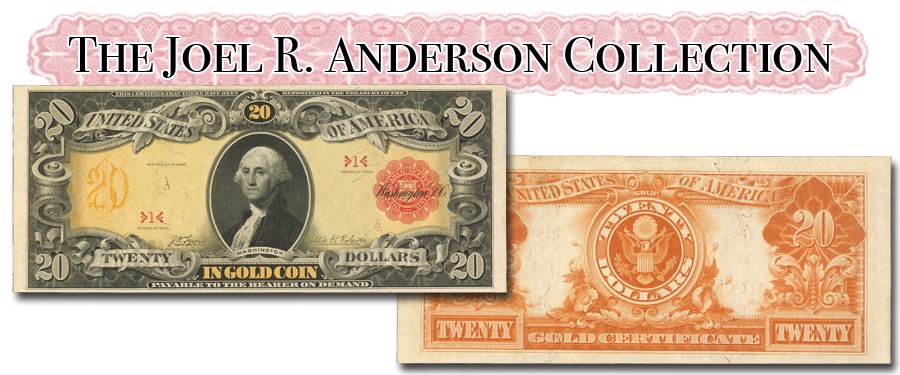
The Joel R. Anderson
Collection of large-size federal paper money by design types has no parallel in
numismatic history. “Rare” becomes common in a way! No sale has ever had so
many unique and Condition Census notes.
From Part 2 of the
collection I have picked out for this week’s discussion what is probably the
most “popular” of his rarities—a classic bill that in any grade creates a lot
of attention.
As might be expected from
the Anderson Collection, this example is beyond special! Read our catalog
description below. And, plan to participate in the sale as a bidder, buyer, or
observer—it will be a unique experience.
Lot
2051.
Incredible
Serial Number 1 “Technicolor” $20 Gold Certificate
Presented
to President Theodore RooseveltOne of the Most Important Notes in Existence!
Friedberg
1179 (Whitman-2225). 1905 $20 Gold Certificate. PCGS Currency Gem New 65 PPQ.
Serial Number 1.
This is an incredible
serial number 1 1905 $20 “Technicolor” Gold Certificate with a provenance that
traces all the way back to the White House. It has a unique history with the
Theodore Roosevelt connection, combined with incredible rarity as the serial
number 1 note. Beyond this, the numismatic fame of the “Technicolor” Note is
everlasting.
It is the Fr. 1179
Lyons-Roberts signed variety (the first of two signature combinations for the
type), and the very first $20 “Technicolor” printed and issued. These Series of
1905 Gold Certificates have a portrait of George Washington, engraved by Alfred
Sealey, and a bright red scalloped Treasury Seal and serial numbers. The field
is gold in color and includes a $20 emblem at left. The vibrant tints and
overprint featured on this type explain the “Technicolor” nickname, by which
these notes are so well known. The back displays the Heraldic Eagle of the
Great Seal of the United States at the center and has ornately engraved
borders. The entire back design, engraved by Robert Ponickau, is executed in
orange-gold.
This note first appeared
in Barney Bluestone’s March 1945 offering of the Albert A. Grinnell Collection,
where it was partially described as: “one of the most attractive notes ever
issued by our government. The beautiful lathe work comprising the frame design
surrounds the rich yellow field in the center of which appears the dignified
portrait of Washington. Above center is ‘20’ in yellow and below the portrait,
the words ‘In Gold Coin’ also printed in rich yellow. The color contrast
effects present a picture comparable to a magnificent painting and must be seen
to be fully appreciated. This colorful beauty is an absolutely perfect, Crisp,
Unc.”
Bluestone, based in
Syracuse, New York, entered the auction business in the 1930s and handled many
rarities. His catalogs are so elusive today that the items he handled have
never been carefully studied.
Grinnell was a partner in
the Grinnell Brothers chain of music stores based in Detroit, each with a
showroom of pianos, musical instruments, sheet music, phonographs, radios and
other items. Albert was alone in his study and pursuit of federal paper money,
without much if any studied competition (Col. E.H.R. Green hoarded paper but
did not study it).
A worth successor to Grinnell’s
passion was Amon Carter, Sr., followed by his son, Amon Jr.
The “Technicolor”
nickname was applied years later with it being the name of a film process
developed in the 1930s.
Indeed few types in
American paper money rival this in terms of aesthetic appeal. The presently
offered piece offers an idyllic level of preservation with excellent centering
and abundant margins. The colors are vibrant, as should be expected from the
first note to roll off of the press. The all-important serial number 1s are
boldly inked and seen with punch through embossing. This note is a true Gem in
every sense of the word, a numismatic treasure, a bona fide trophy note that
will be a centerpiece in any collection it enters.
Research tells us that
this very note was the presentation piece given to President Theodore Roosevelt
by then Secretary of the Treasury Leslie Mortimer Shaw. While it had long been
rumored that this note had been part of Roosevelt’s personal holdings, that
fact can be confirmed by a handwritten note which accompanied the sale of the
serial number 3 example in 2005. The note reads “Mr. Shaw, Secy. of Treasury
during Theodore Roosevelt’s administration, gave to the president, No. 1 of
this series, No. 2 to himself & No. 3 to Gilbert G. Thorne, of $20 gold
notes issued at that time.”
President Roosevelt’s
interest in America’s circulating currency is well documented. He worked
closely with sculptor Augustus Saint-Gaudens on redesigns of the country’s $10
and $20 gold coins which were minted from 1907 to 1933. It is no stretch to
think Roosevelt may have had some influence on the creation of this stunning
$20 Gold Certificate. The Roosevelt connection has gone unmentioned in all
previous auction appearances of this note that we can trace.
If there is one “Trophy
Note” that will be the centerpiece of the greatest private or museum collection
of paper money, this is it!
PCGS
Population: 1, none finer.
From
Barney Bluestone’s sale of the Albert A. Grinnell Collection, March 1945, lot
751; William Donlon Numismatist Ad of October 1964; Currency Auctions of
America’s sale of May 2001, lot 1373; Heritage Auctions’ sale of February 2005,
lot 16797.
Est.
$300,000-$500,000





